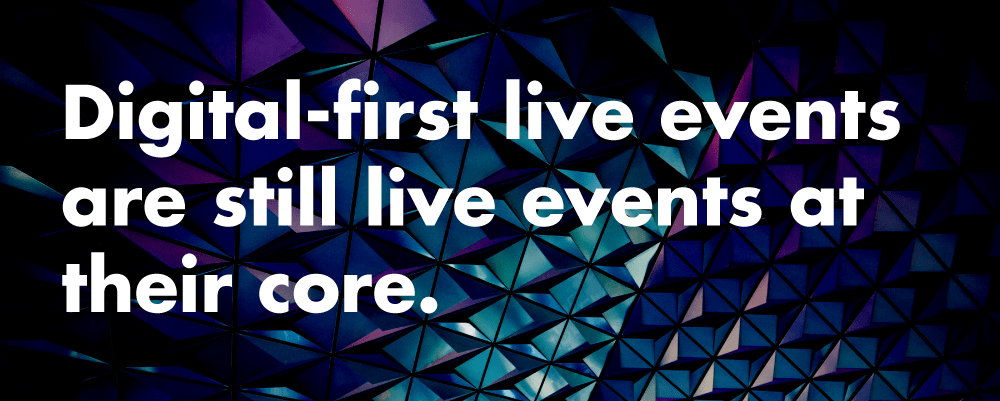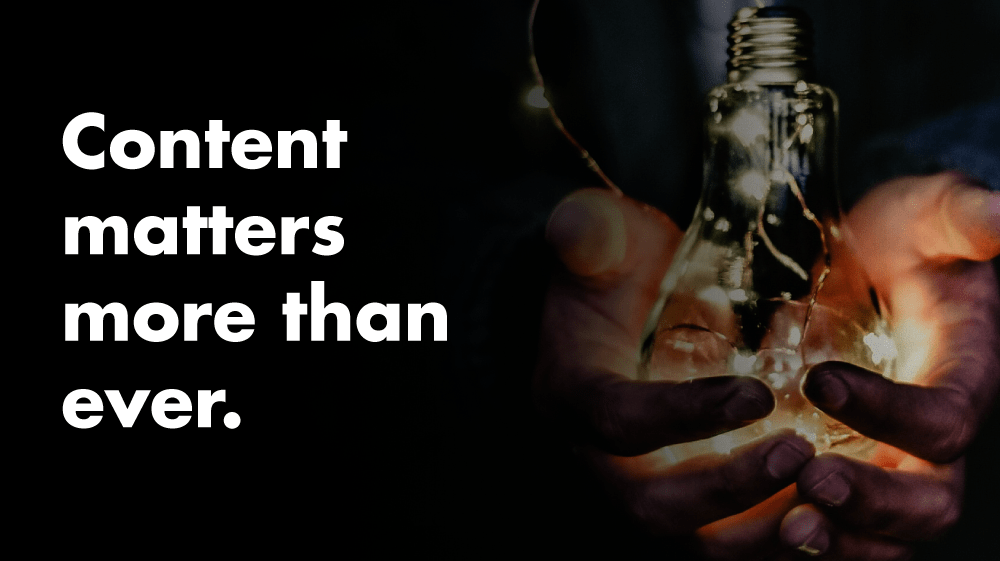Jack Blog
April 1st, 2020 By Jack Morton
Walter Soyka is a consultant at Jack Morton. This story was originally published on LinkedIn.
Coronavirus is causing uncertainty around gatherings
Coronavirus is threatening our industry, canceling in-person meetings around the world. And with good reason: COVID-19 is dangerous. Cutting in-person gatherings for events is a wise and responsible decision.
No one’s traveling for business right now, but that doesn’t mean no one needs events. Our clients still have real business needs. They need to make product announcements. They need to connect internal teams. They need to interact with customers. They need to inform investors and the press.
They still want us to run their events as scheduled — but now we need to run those events digitally.
Event creatives and producers face tough, new questions. How can we engage our event audiences online? What practices can we keep from our experience with live-first events? What do we need to adapt for digital-first?
Earning audience attention is our biggest challenge
Live events are big, immersive, shared experiences. They engage all our senses, and connect us with our peers.
Far too often, though, webcasts are just one browser tab amid a dozen others. Viewers push webcasts into the background while sifting through email, Slack, and a dozen other distractions.
What’s the biggest challenge that online events face? It’s continually earning each individual audience member’s attention. There’s got to be something in it for them that justifies their time commitment.
Think of any webcast you’ve ever attended yourself, and you’ll have immediate empathy with your next online audience. So what can we do to provide real value to our clients and our audiences?

Creative tactics for engaging online audiences
Our studio, Keen Live, designs visuals and workflows for screens big and small. We’d like to share some key creative tactics from our experiences over the years that you can fold into your own approach to digital-first events today:
- Not everyone in your audience will engage the same way. Some people may be interested in the program as a whole, while others might be interested in specific segments or tracks. It’s possible to serve both segments, but plan your session content accordingly. On-demand access to pieces of your online event can eliminate attendee agenda conflicts. Daily highlight reels offer ready-to-share Cliffs Notes version of the event — perfect for people who do not have the bandwidth for full-time engagement.
- Walk-in still exists — it just looks a little different. You’d never put up a slide in an arena that says, “Our session will begin in 10 minutes.” Why should that be the first experience an attendee has when connecting to your stream? Produce meaningful pre-show content and start the stream early.
- Audiences expect live hosts. Live events encourage people to engage with each other, but online experiences can be isolating. Using a host will make your event more relatable, and can help provide continuity across segments and tracks.
- Opening videos work differently. A live event opening video is a crowd settler, but it’s not a live audience’s first touchpoint with your brand. They’ve already been immersed in your branded space for hours. A digital-first opening video needs to establish that same brand connection right away. Practically, an in-person opening can start with something that generates curiosity and end with “Welcome to insert-your-event-here,” but a digital-first opening should lead with the welcome.
- Staging transitions should flow quickly. Every slow transition in your show is an invitation for a viewer to check their email. Make sure your scripts connect one segment to the next. Tease what’s coming next, before the transition, to give people a reason to stay. I’ve seen two models work really well: the roller coaster (cycles of anticipation and pay-off) and the runaway train (constant acceleration).
- Deliver press kits to influencers. At any big public event, the press captures imagery that they publish to drive the client’s unpaid or earned media. You’ll have to provide your influencers the video, b-roll and photos they need.
- Don’t abandon interactivity. There’s a lot that happens at a meeting that doesn’t translate to one-way webcasts. Most streaming platforms have features like chats and polls. You can and should develop seed content for these. When you run a chat channel alongside your stream, dedicate someone to answer questions and moderate Q&A for the speaker.
Design tactics for digital-first live events
With the live events industry moving to digital-first delivery, our design teams need to work toward new goals. Our sense of space is very different in a browser tab than an arena. Our design surfaces have different proportions and scale relationships to the presenters. Broadcast design relies on different techniques to earn audience attention. Here are some ideas to bridge that gap:
- Express brand identity and keep viewers up to speed with a full broadcast graphics package. Borrow broadcast content techniques for your stream. A well-designed broadcast package should express the brand visually. Remember: you’ve lost all your in-venue signage. It should also give viewers the information they need about the program at a glance. Broadcast graphics serve a different function than speaker support does. They help the viewer understand the program, not the content.
- Speaker support graphics move when they first appear on broadcasts. Motion is an important cue in a stream which might otherwise feature a lot of talking heads. It’s an obvious visual cue that there’s new information on screen. Make sure your speaker support moves when it enters to provide viewers that clear signal.
- Think “studio” with your scenic and lighting. Live event sets are usually staged theatrically. They have a single plane of interest that the entire audience can see from wherever they sit. When you can put a camera anywhere you want, this limitation vanishes. You can create one set with different areas, or you can create different sets altogether. You can tune these spaces to different kinds of content, without losing intimacy.
- Video scenic gives a fresh alternative to cutting between talking heads and full-frame graphics. Add video LEDs or monitors to your scenic design to create a high-impact environment for your stream. Patriot Act with Hasan Minhaj on Netflix is a great example of how well this technique can earn and maintain a viewer’s attention. You’ll need custom content, but the production value payoff is huge.
- AR/XR takes video scenic to the next level. Augmented reality is a sideshow gimmick at most live events. After all, the audience can see actual reality right in front of them. However, when the audience only sees through the camera, AR can provide some novel wow factor. AR is not right for all programs, but in some cases, the extra immersion will drive a narrative. Think of AR for scenic extensions, product demos, and mechanism-of-action explanations.
- Previsualize your content to understand how it will appear on the stream. Video scenic or AR calls for previsualization from the beginning. For stage shows, we usually previsualize one or two audience perspectives. For a webcast, we’d previsualize all camera perspectives and show how they intercut. This helps secure client buy-in during production. It also gets the whole production team on the same page before you roll into the studio.
- Thoughtful sound design re-engages drifting viewers. The “breaking news” telegraph music cue is a cliche, but think about the purpose it serves. It signals new content to active viewers, and it wins back the attention of viewers who have drifted away. You only get two senses with a webcast: sight and sound. Don’t underestimate the power of sound design. Be sure to execute it consistently and judiciously throughout your program.
Production tactics for putting big events on small screens

A lot of what we know about producing traditional events translates. There are new production considerations, too. Some are obvious, like cameras, switchers, and a streaming platform. Here are some others we’ve noticed:
- Stage presence and camera presence are not the same thing. Give your presenters someone to play to. It’s good for the presenter, and it’s good for your remote audience. An interviewer or a studio audience can help your presenters give their best performances. They also give the remote viewers a proxy they can relate to.
- Get the right gear for the gig. The broadcast sets you see on TV have come with extensive control rooms and expensive price tags. You can get much better bang-for-the-buck with a little bit of planning. Start with a solid idea of what you want to accomplish on-screen, then talk with both your AV and media vendors. They’ll help you target video systems to your needs.
- Moving cameras add production value. If you’ve already invested in strong scenic for your studio, look at specialty cameras like jibs, JITAs, and Steadicams, too. They can add a lot of production value with sweeping shots. These shots are strongest in two scenarios: keeping visual interest high over a staging transition or studio-audience applause moment, and signaling emphasis around the delivery of a key message.
- You don’t have to go live for everything. There are no do-overs for live events in-person, but that limitation need not apply for a webcast. Consider running a few performances live-to-tape. You can select the best full run for broadcast, or even edit the best takes together for maximum polish. Even if you run your main program live, you can still pre-produce some content as packages for roll-in.
- Lean into the parts that are live. A little “LIVE” bug in the corner of a broadcast tells the audience that they’re seeing something fresh. If you are consistently delivering a solid program and engaging content, your audiences will overlook a flub or two. Small mistakes are authentic, everyday occurrences on broadcast television, but have a backup plan for larger failures.
- Drive hybrid live/broadcast events from the truck, not from the deck — but also drive collaboration across crews. The event crew and the broadcast crew should be unified under a single director. The director calls cameras while a trusted assistant calls on-stage action. In-venue show callers tend to think of the room, not of the screen. It’s important that the show’s director has experience with live-events-to-broadcast, like awards shows. A collaborative attitude and willingness to work across departments is a must.
Break a leg. (Or maybe a mouse.)
The move to digital-first delivery affects all event disciplines. As an industry, we have great staging experience that we can still apply — but we also need to tweak our approach, and layer on some new tools and techniques to best serve our clients.

Collectively, we have the creativity, talent and experience and to deliver it digitally — with the high production value and high engagement that our clients have come to expect.
I hope you keep busy, stay healthy, and continue wowing your audiences in the months to come!
—-
Learn more about designing an optimal virtual broadcast experience from Jim Fenhagen, Jack’s SVP, Design and award-winning innovative set designer with more than 30 years of experience.